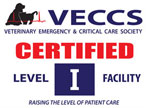Date:
As the weather changes, so do the threats to our pets. With warmer weather comes the re-emergence of species that have been dormant during the winter months. South Carolina is home to five of the deadliest snakes in North America, which include the cottonmouth (water moccasin), rattlesnakes (timber rattlesnake, eastern diamondback rattlesnake), copperhead, and coral snake.
Here in the Lowcountry, snakes pose an increasingly more common hazard in the spring and summer months. While found more abundantly in rural communities and undeveloped areas, urban pets are not free of risk.
Types of Snake Bites & Effects
The most common species encountered in Charleston is the copperhead, which possesses a toxin known to cause severe tissue damage (even slough), as well as clotting problems and injury to the organs that process the toxin, though many pets make a full recovery with proper treatment.
Rattlesnakes, however, possess a potent toxin that suppresses the nervous (brain and nerves) and respiratory systems, causing a rapidly progressive loss of consciousness and breathing difficulties, which are very often life threatening. Similar respiratory difficulties develop with coral snake envenomation. Though treatment of copperhead snake bites includes primarily fluid therapy, pain medications and, if necessary, wound care, rattlesnake and coral snake bites require rapid and much more aggressive life-saving therapies.
Factors Affecting the Severity of a Bite
The size of the pet, location of the bite, and whether it is a dog or cat determine the severity of the venomous bite. Cats tend to be more resistant to snake venom than dogs and perhaps due to their size and hunting behavior, tend to suffer snake bites to their torso. In contrast, dogs are most commonly bitten in their face, tongue, eyes and neck. Bites in these areas are more serious since the venom is often delivered directly into the victim’s bloodstream. Adult snakes and juveniles may inject different amounts of venom, and some bites may not be venomous at all (dry bites).
Safety Precautions
Most snake bites in pets are to the face, neck, and limbs in animals that are sniffing around objects where snakes tend to hide. To avoid these chance encounters, keep these tips in mind:
- Keep your yard tidy by clearing away undergrowth, toys, and tools that make great hiding places for snakes.
- Keep walkways clear of brush, flowers and shrubs.
- Clean up any spilled food, fruit or bird seed, which can attract rodents-and therefore snakes-to your yard.
- When walking pets, keep them on a leash.
- Steer your pet clear of long grasses, bushes, timber, and rocks which provide camouflage.
- Snakes can strike across a distance equal to about half their body length. If you see a snake, head back the way you came.
- Familiarize yourself with snakes who are common in your area. In the event of a bite, identifying the type of snake may help with your pet’s treatment.
Treatments to Avoid
Several “old wives tales” exist regarding treatment of venomous snakebites at home or in the field. These include application of ice to the bite site to constrict blood vessels and slow spread of the toxin, making cuts in the skin near the bite wound to encourage the toxin to be “bled” from the body, directly sucking on the wound to try to draw the venom out through where it entered, or applying a tourniquet to the limb above the bite to contain the toxin and prevent its spread through the body. However, research has shown that these steps do not improve outcome and rather can cause worse illness or make treatment more difficult in the long run. Instead, immediate and aggressive evaluation and treatment by a veterinarian is advised.
Getting Help
If your pet is bitten by a snake, it is important that you seek veterinary care immediately. CVRC is ready 24/7 to treat snakes bites and all types of emergencies. We stock anti-venom for use when needed as an antidote to venomous bites. We can be reached any time of the day or night by calling 843.614.8387.








